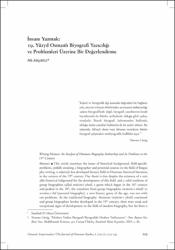İnsanı Yazmak: 19. Yüzyıl Osmanlı Biyografi Yazıcılığı ve Problemleri Üzerine Bir Değerlendirme
Abstract
Bu makalede, Osmanlı tarih literatüründe zayıf bir alan ve edebî tür olan bi- yografi yazıcılığında tarihî zemin, imkânlar, sorunlar ve eserini kaleme alan biyografı bekleyen tehlikeler, özellikle 19. yüzyıl bağlamında ele alınmıştır. Temel tezimiz bu alanın gelişebilmesi için uygun bir tarihî zemin olmasına ve 16. yüzyıl ile başlayıp 18. yüzyılda zirvesine çıkan terâcim-i ahvâl denilen grup biyografilerinin gayet sağlam bir geleneği bulunmasına rağmen, terâcim-i ahvâl üzerinden, yeni bir edebî tür olan tercüme-i hâle, yani şahıs biyografilerine geçişte bir sorunun yaşandığıdır. Bununla birlikte 19. yüzyıldan itibaren bir yandan önceki dönemlerden intikal eden gele- neksel terâcim literatürü devam ettirilip grup biyografi serileri tamamlanırken diğer yandan modern biyografi alanında cılız ve istisnai de olsa bazı gelişmeler yaşanır; ancak, bunların yeterli ve tatmin edici ölçekte olmadığının da ifade edilmesi gere- kir. Bu yazı, tarihî temelleri ve geleneği gayet sağlam olmasına karşın yeterince ilgi görmeyen ve güçlü örnek ve ürünler veremeyen biyografi türünün gelişememesinin yapısal arkaplanı, biyografik verilerin durumu ve problemleri, biyografi konusunda sınırlı bilgiler sunsa da mevcut veri kaynaklarını kullanan araştırmacıları bekleyen tehlike ve tuzakları, ayrıca, modern dönemin her şeye rağmen biyograflara sunduğu yeni imkânları ele almaktadır.
-
This article examines the issues of historical background, field-specific problems, pitfalls awaiting a biographer and potential sources in the field of biogra- phy writing, a relatively less developed literary field in Ottoman historical literature, in the context of the 19 th century. Our thesis is that despite the existence of a suit- able historical bakground for the development of this field, and a solid tradition of group biographies called terâcim-i ahvâl, a genre which began in the 16 th century and peaked in the 18 th , the transition from group biographies (terâcim-i ahvâl) to tercüme-i hâl (personal biography), a new literary genre of the age, was not with- out problems. As the traditional biography literature (terâcim-i ahvâl) continued and group biographies further developed in the 19 th century, there were weak and exceptional signs of development in the field of modern biography, but far from a sufficient level. This article discusses the structural factors in the underdevelopment of the biography genre, a genre which has not drawn sufficient attention despite its strong historical roots and tradition and which has not produced significant, good examples. It also examines the condition of biographical data and its problems, pit- falls awaiting a researcher in exploiting the available sources no matter how little information they provide, and the new potentials the modern age presents for the biographers despite all these handicaps. This article examines the issues of historical background, field-specific problems, pitfalls awaiting a biographer and potential sources in the field of biogra- phy writing, a relatively less developed literary field in Ottoman historical literature, in the context of the 19 th century. Our thesis is that despite the existence of a suit- able historical bakground for the development of this field, and a solid tradition of group biographies called terâcim-i ahvâl, a genre which began in the 16 th century and peaked in the 18 th , the transition from group biographies (terâcim-i ahvâl) to tercüme-i hâl (personal biography), a new literary genre of the age, was not with- out problems. As the traditional biography literature (terâcim-i ahvâl) continued and group biographies further developed in the 19 th century, there were weak and exceptional signs of development in the field of modern biography, but far from a sufficient level. This article discusses the structural factors in the underdevelopment of the biography genre, a genre which has not drawn sufficient attention despite its strong historical roots and tradition and which has not produced significant, good examples. It also examines the condition of biographical data and its problems, pit- falls awaiting a researcher in exploiting the available sources no matter how little information they provide, and the new potentials the modern age presents for the biographers despite all these handicaps. İstanbul 29 Mayıs Üniversitesi Senatosunun 22.06.2020 tarihli ve 2020/14-5 sayılı Açık Bilim Politikası gereğince erişime açılmıştır.


















